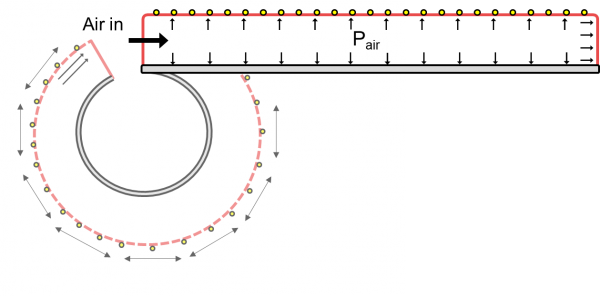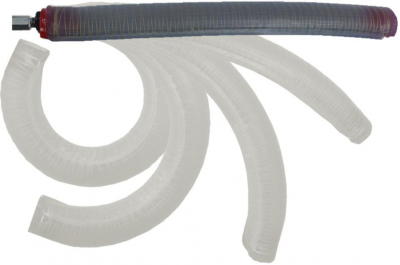|
Fiber-reinforced actuators are a class of soft actuator that have been developed by a number of research groups around the world in recent years. The basic design consists of an elastomer bladder wrapped with inextensible reinforcements. |
|
| The inner bladder acts like any typical balloon; when inflated it tries to expand in all directions. |
|
| Wrapping the bladder with inextensible fibers constrains it from expanding radially; when inflated it can only expand in the axial direction. |  |
| Adding a sheet of inextensible material prevents the actuator from expanding in the region of that sheet; since one side expands axially and one doesn't, the actuator bends when inflated. |  |
This documentation set contains files and instructions to support the design, fabrication, modeling, and testing of a bending actuator; however it is possible to use the approach described here to make actuators with a wide range of motions.
The placement of the reinforcements defines the type of motion achieved when the bladder is inflated. By selecting the appropriate placement, it is possible to achieve combinations of bending, extension, and twisting. This page explains how to design different motion types into your actuator. It is even possible to achieve different behaviors along the length of a single actuator. This documentation set includes a case study of a thumb assist device that incorporates an actuator that undergoes bending, twisting, and extension when inflated.
Compared to PneuNets bending actuators, the fiber-reinforced actuators have some advantages and disadvantages. On the one hand, the fiber-reinforced actuators can achieve a wider range of motions and are more robust as they have a smaller "seam" area: PneuNets have a seam around the entire perimeter where the top piece is bonded to the base layer, while fiber reinforced actuators only have a small seam at the end caps. This reduces the risk of delamination failure. On the other hand, the fabrication process for fiber-reinforced actuators is a lot more time- and resource-intensive: whereas a PneuNets actuator can be cast and assembled in less than an hour using three 3D-printed mold pieces, casting a fiber-reinforced actuator can take up to 5 days and requires six 3D-printed mold pieces. The selection of which type of actuator to use will depend upon your application, time constraints, and available resources.
| Some of the information contained in this web site includes intellectual property covered by both issued and pending patent applications. It is intended solely for research, educational and scholarly purposes by not-for-profit research organizations. If you have interest in specific technologies for commercial applications, please contact us here. |


